![]()
![]()
![]()
Use LEFT and RIGHT arrow keys to navigate between flashcards;
Use UP and DOWN arrow keys to flip the card;
H to show hint;
A reads text to speech;
57 Cards in this Set
- Front
- Back
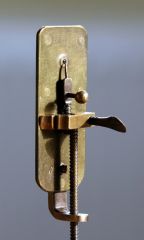
An inventor of the microscope. His microscopes were made of a single lens and could magnify from 270X-500X. He termed tiny organisms "animalcules" (beasties) |
van Leeuwenhoek |
|
|
Study of organisms too small to see by the unaided eye |
Microbiology |
|
|
Organisms considered to be microorganisms |
1) Bacteria 2) Fungi 3) Virus 4) Protozoa 5) Algae 6) Archaea 7) Parasitic Worms |
|
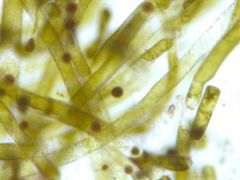
Unicellular or multicellular photosynthetic eurkaryotes |
Algae |
|
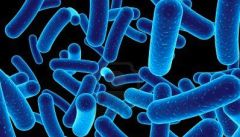
Groups of single-cell organisms that are prokaryotes. The cells of this group have a cell wall and are generally smaller than eukaryotes. An example of a member of this group is Staphylococcus aureus which is the most common nosocomial infection. |
Bacteria |
|
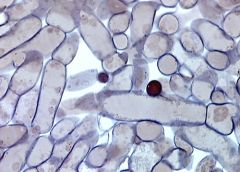
Group of organisms whose cells are eukaryotic and must obtain food from other organisms. They differ from animal cells because they have a cell wall. A representative of this group is brewer's and baker's yeast. |
Fungi |
|
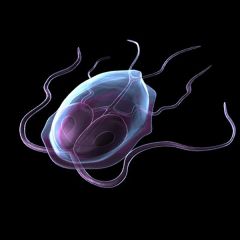
Single-celled microorganisms that are similar to animal cells in nutritional needs and cellular structure. Most are capable of motion through use of pseudopodia, cilia, or flagella |
Protozoa |
|
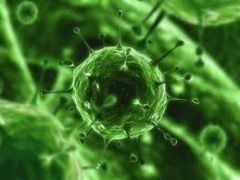
Generic term for a group of organisms whose members are extremely small. Technically, this group is not alive. An example is Ebola. |
Virus |
|
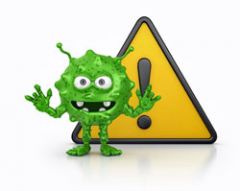
Microorganism that causes disease in humans |
Pathogen |
|
|
Term for the origin of life that states that new organisms come from parental organisms. |
Biogenesis |
|
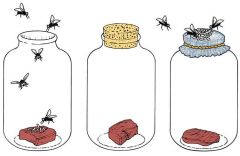
Term for the origin of life that states that lower forms of life arose from precursors or rotting material |
Spontaneous generation |
|
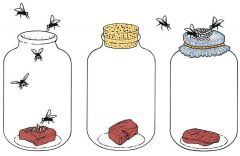
Scientist that dispelled the notion of spontaneous generation in macroorganisms when he placed a piece of meat into a jar that was covered by a net. |
Redi |
|

Scientist who presented evidence for spontaneous generation. He proposed that there was a "life force" that causes inanimate matter to spontaneously come to life. Although incorrect, his improper sterilization lead to the discovery of spores. |
Needham |
|
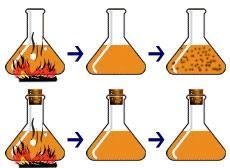
Scientist who showed not even microorganisms can come from nonliving things. He cooked broth in a flask which was then sealed. He observed no growth in the broth. When the flask was opened, growth was apparent indicating that microorganisms came from that air that entered the flask. |
Spallanzani |
|

"King" of microbiology. He disproved spontaneous generation by performing experiments with swan-necked flasks. He also developed methods to kill microbes that cause spoilage in food (although many other microorganisms survive!) |
Pasteur |
|
|
Scientific Method |
Observation->Hypothesis->Experiment->Results (repeat Experiment) ->Conclusion ....Theory->Law or Principle |
|
|
Educated guess to explain a phenomenon. It proposes a testable set of factors that will result in the phenomenon. |
Hypothesis |
|

Scientist that was an inventor of the microscope. His microscope has a single lens that could magnify up to 30X. He used his microscope to describe the structure of cork. |
Hooke |
|
|
Cell Theory |
*All known living things are made up of cell *The cells is the structural and functional unit of all living things *All cells come from pre-existing cells by division *Cells contain hereditary info that is passed from cell to cell during cell division *All chemicals are basically the same in chemical composition *All energy flow (metabolism) of life occurs within cells. |
|
|
Two scientists that described the structure of animal and plant cells. They proposed that all living things are made from smaller units and that new units come from pre-existing units by division. |
Schleiden & Schwann |
|
|
Hypothesis formulated by Pasteur in 1857 that microorganisms are responsible for disease |
Germ Theory of Disease |
|
|
Austrian-Hungarian physician that instituted practices to reduce puerperal (childbed) fever in maternity wards. He is considered the pioneer of antiseptic policy and the prevention of nosocomial infection. |
Semmelweis |
|
|
Techniques that eliminate transfer of microorganisms from one place to another |
Antiseptic Technique |
|
|
British surgeon considered to be the father of modern surgery. He developed procedures to sterilize surgical instruments and clean wounds using aseptic technique. |
Lister |
|
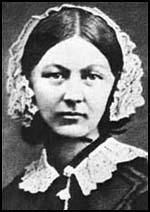
Founder of modern nursing; found that poor nutrition and unsanitary conditions led to high death rate of wounded soldiers |
Nightingale |
|
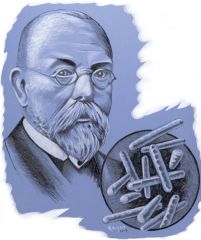
Scientist that is considered to be the father of bacteriology. He was the first scientist to use agar to solidify culture medium. He devised a method to identify the specific microorganism that is causing a disease. |
Koch |
|

Koch's Postulates |
*The organism must be found in all animals suffering from the disease, but not in healthy animals *The organism must be isolated from a diseased animal and grown in a pure culture *The cultured organism should cause disease when introduced into a healthy animal *The organism must be re-isolated from the experimentally infected animal. |
|
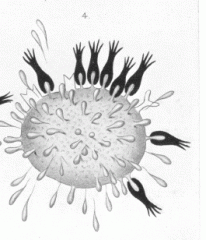
Scientist that coined the phrases "chemotherapy" and "magic bullet". He also invented a precursor technique to the Gram stain. |
Ehrlich |
|
|
Antimicrobial drug developed Gerhard Domagk. It undergoes bioactivation in the liver to become sulfanilamide. This drug is a member of the sulfa drugs, a class of drugs still in use today |
Prontosil |
|
|
Microbiologist that discovered lysozyme, an antimicrobial enzyme that is produced in tears. He is most noted for observing that a colony of mold (Penicillium) could inhibit the growth of bacterial (S. aureus) cells. This led him to propose antibiosis. |
Flemming |
|
|
Term used to describe natural antimicrobial products that are modified in a laboratory to make them more effective. |
Semisynthetic |
|
|
Scientist that was first to use variolation to give individuals protection from smallpox. A thread was dipped into the fluid of smallpox vesicle. The thread was then drawn through the skin of an individual. Often the procedure would work but there was a high risk of smallpox transmission. |
Montague |
|
|
The study of the body's specific defenses against pathogens. |
Immunology |
|
|
2 Prokaryotic Microbes |
Bacteria & Archaea |
|
|
Microbes with cell walls |
Bacteria & Archaea |
|
|
Eukaryotic Microorganisms |
Fungi, Protozoa, Algae, Parasitic Worms |
|
|
Types of Fungi & How Many Cells |
1) Yeast - Unicellular 2) Mold - Multicellular |
|
|
Protozoa - Acellular, Unicellular, Multicellular? |
Unicellular |
|
|
Algae Properties |
Unicellular or Multicellular Photosynthetic Eukaryotes |
|
|
Virus Properties |
Acellular Obligatory parasites composed of small amount of genetic material |
|
|
Scientist to put an end to the theory of spontaneous generation? |
Louis Pasteur |
|
|
Scientist to discover bacteria caused disease |
Koch (anthrax) |
|
|
Binomial Nomenclature |
2 names given to specific organism |
|
|
7 Steps of Classification |
Kingdom, Phylum, Class, Order, Family, Genus, Specific epithet (Species)
(Kate, Please Come Over For Great Sex) |
|
|
The 5 Kingdoms |
(Robert Whittaker)
Monera (or Prokaryotae) Protista Fungi Animalia Plantae |
|
|
A system of "either-or" choices |
Dichotomous Key |
|
|
Scientist that improved upon the 5 kingdom classification system and organized it into 3 domains. This is necessary since archaebacteria are different from eubacteria and eukaryotes. |
Woese |
|
|
Kingdom of organisms that lack internal organelles, are unicellular, and have a cell size smaller than eukaryotes |
Prokaryotae |
|
|
Kingdom whose organisms are all eukaryotes, some are capable of movement, some are capable of photosynthesis, and can reproduce asexually as well as sexually |
Protista |
|
|
Group of microorganisms that cannot be classified into the 5 kingdoms because they are not alive. Microorganisms in this group are very specific with regard to the species and type of cells they infect and reproduce |
Viruses |
|
|
Cells that lack nucleus |
Prokaryote |
|
|
Kingdom whose organisms are all eukaryotes, multicellular, capable of photosynthesis, and can reproduce asexually as well as sexually |
Kingdom Plantae |
|
|
Domain of prokaryote organisms that can be found in our every day environment. There may be 50 kingdom of organisms in this domain. |
Bacteria |
|
|
Kingdom whose organisms are all eukaryotes, multicellular, DO NOT have cell walls, and reproduce sexually. Reproduction of new organisms involves development from an embryo. |
Kingdom Animalia |
|
|
Kingdom whose organisms are all eukaryotes, saprophytic and can be unicellular or multicelluar |
Fungi |
|
|
Domain of prokaryote organisms that live in extreme environments i.e. hot sulphur springs, deep ocean thermal vents. They have differences in cell walls structure and rRNA from other bacteria. There may be 3 kingdom of organisms in this domain. |
Archaea |
|
|
The ways in which organisms are grouped should reflect their evolution from common ancestors |
Phylogenetic hierarchy |

